Seascape photography is, without a doubt, one of the most exciting types of landscape photography.
There are countless ways to approach coastal photography, but they all have one element in common: the water. Water can be used as the main subject in your seascape photos, but it can also be used to integrate and connect all the elements of your composition.
However, ocean photography is not as simple as general landscape photography. There are many complex factors that you need to control and be aware of if you want to succeed.
Photographing the sea is my passion. I live by the ocean and I’ve been shooting seascapes since I first picked up my camera many years ago, so I decided to create this coastal photography guide. Here, you’ll learn how to capture the ocean, the best settings for seascape photography, and, lastly, a few extra tips and all the gear you need to become a better seascape photographer.
Ready to get wet and push your seascape photography to the next level?
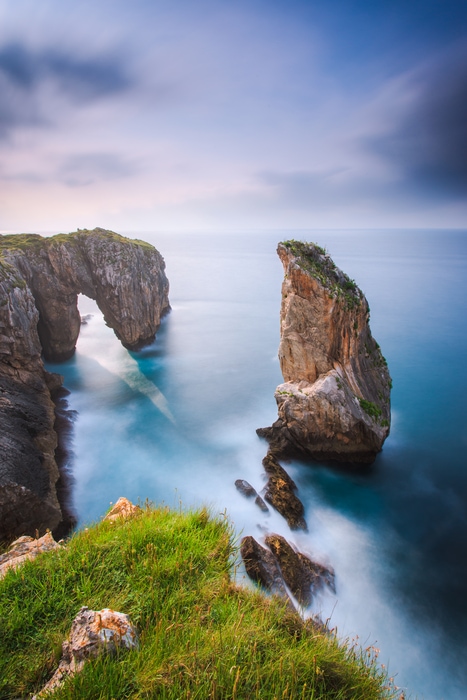
Asturias, Spain – f/16, 90s. ISO 100
- What is seascape photography?
- Seascape photography planning
- Best seascape photography settings
- Gear for sea photography
- 10 seascape photography tips
- 20 best seascape photography ideas
What is seascape photography?
In a few words, seascape photography is a type of landscape photography where the sea is the main subject instead of a piece of land. It’s considered a subgenre of landscape photography because this type of photography usually involves shooting pieces of land like rocks, cliffs, mountains, etc.
Seascape photography is also known as coastal photography or ocean photography, and the water is usually the main subject across the different types of seascapes that you can photograph.

Seascape photography is a type of landscape photography where the main subject to photograph is the sea. Cathedral rocks, Australia – 16mm f/11, 0.4s, ISO400.
How to plan for ocean photography
Generally, behind any great landscape photo, there is extensive planning. In seascape photography, this planning is even more crucial since there are more elements that come into play like waves, storms, tides, etc.
When shooting the ocean, we’re also in a more vulnerable position, so you should always plan to minimize the hazards of practicing seascape photography.
What is the best time for coastal photography?
Photographing seascapes can be done at any time. However, there are certain times that are usually best suited for any type of beach photography.
Now, we’ll dive into the different scenarios and types of coastal photography that you can shoot depending on the time of the day:
Sunrise/Sunset seascape photography
One of the best times to do ocean landscape photography is at sunrise or sunset. Being able to photograph beautiful seascapes painted with golden sunlight is a magical experience.
The change of light when the sun rises or sets allows you to shoot different seascapes; from capturing the sea flows by doing long exposure photography to freezing the motion of the breaking waves using a fast shutter speed.
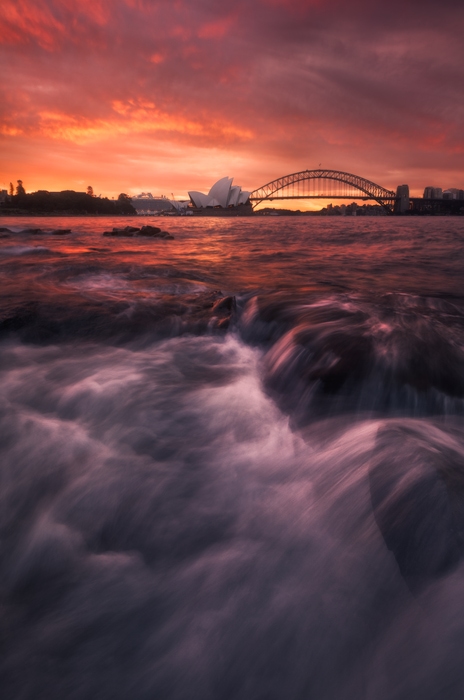
Sunrise seascape photograph. Sydney, Australia – 1/2 sec. f/11, ISO 250
Daytime seascape photography
Photographing the sea during the day is also possible even though the harsh light can make the shooting conditions much more challenging. Try to photograph seascapes during overcast days, and use lens filters to add a dreamy and ethereal atmosphere to your images by smoothing the texture of the water and capturing the motion of the clouds.
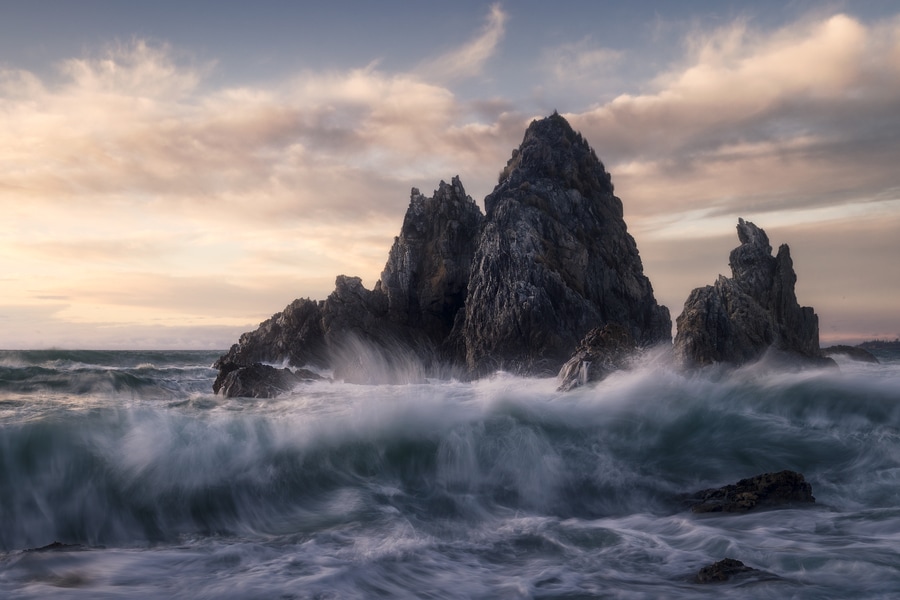
Seascape photograph during the day, Australia – f/13, 0.3s, ISO 100
Night seascape photography
Night coastal photography can be quite daunting. Standing in the water in the middle of the night with the continuous roaring surf is not for everyone, but photographing the sea at night time can be an otherworldly experience. Photographing the beach with a starry sky or the soft moonlight bathing the coastline is something that leaves you in complete awe.
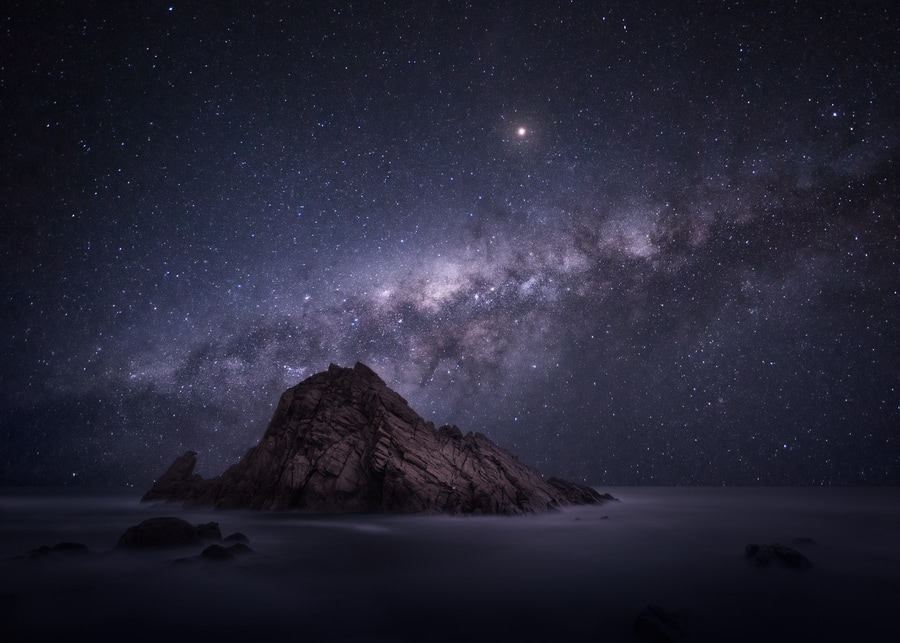
Night seascape image. Sugar Loaf, Australia – f/2.8, 20s. ISO 6400
If you want to improve your night photography skills, I highly recommend you check our guides on how to photograph the Milky Way and how to do long exposure night photography.
Check the weather forecast for sea photography
Understanding weather patterns and checking your local weather forecast prior to doing landscape seascape photography will increase your chances of success and, most importantly, will avoid unnecessary risks. The ocean has a huge impact on the weather, and it’s one of the key elements to consider when doing any type of coastal photography.
The weather also has an important role in the final look of your seascape photographs. Severe weather means more opportunities to capture enormous swells and more dramatic scenes but, at the same time, it will be far from a peaceful sunset on the beach.

The weather plays a fundamental role in seascape photography. Australia – 2sec. f/11, ISO 100
The main things to look for in a weather forecast for seascape photography are:
- Cloud cover
- Cloud altitude
- Temperature
- Water temperature
- Dew point
- Thunderstorms
I normally check and compare the weather forecast on two websites: Windy and Wunderground.
Windy provides a fast and intuitive worldwide weather map that uses the leading local forecast models to provide you the most up-to-date weather forecast.
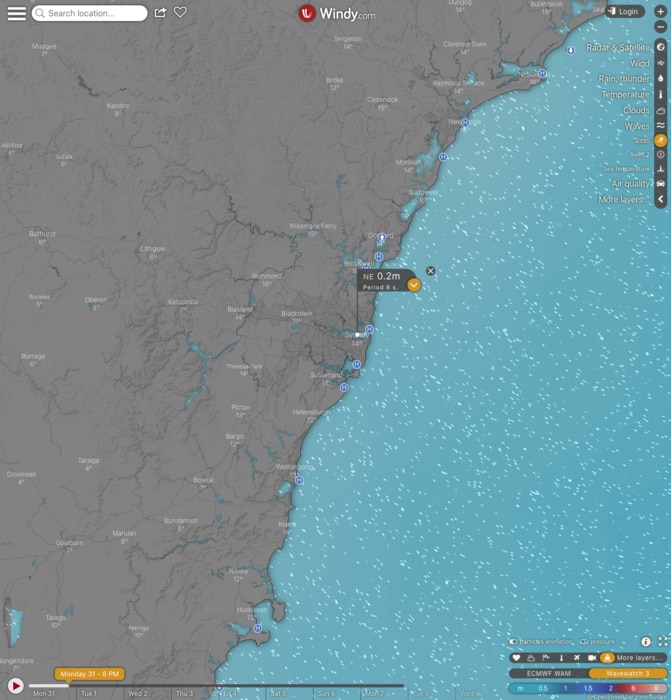
Windy Satellite view forecast
Wunderground is another worldwide weather forecast provider that offers a detailed 10-day forecast, which very useful for planning your seascape photography in advance.
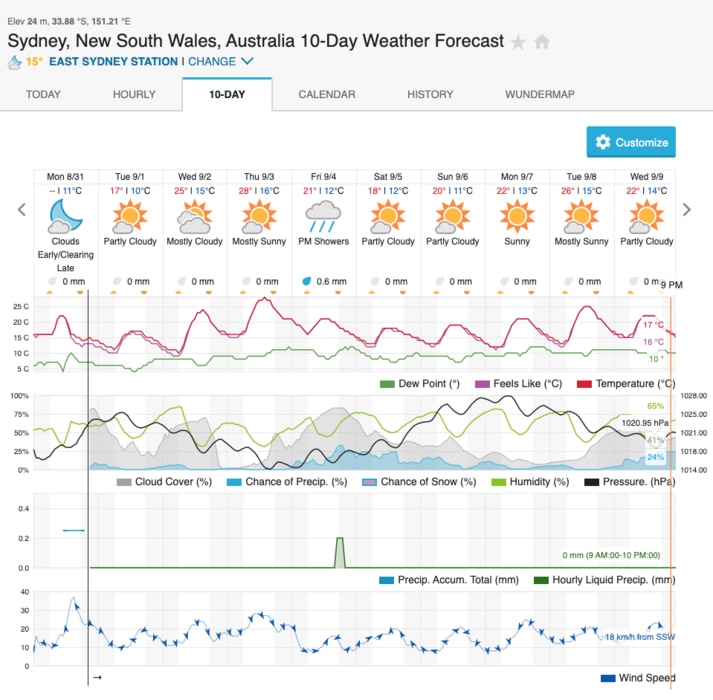
Wunderground 10-day forecast
My recommendation is to always check and compare different forecast models and to take a look at the radar or satellite view before doing any type of coastal photography. That way, you’ll have a more accurate idea of what you’ll find once you’re in the location.
Check the swell and tide, The best tip for coastal photography
When planning your seascape photos, make sure you don’t forget to check the swell and tide. This is one of the best tips for seascape photography, and it will help you avoid unnecessary risks and capture the photos you are looking for.
Seascapes change drastically between tides, and you can experience anything from peaceful sandy beaches to rocky cliffs hit by big waves in just a few hours.
Also, there are some places around the coast, like tidal pools and sea caves, that are only accessible at certain tides and, trust me, you don’t want to find yourself inside of a cave with a rising tide. Checking the tide well in advance will help you plan your ocean photos better and to make the most of your seascape photography sessions.
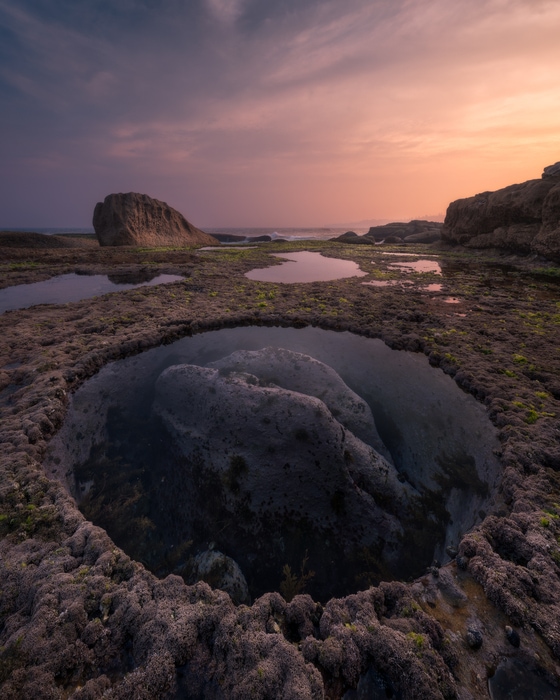
Tidal pool accessible during low tide. Australia – f/11, 1/8s. ISO100
The other factor to consider when doing coastal photography is the swell. Swell can be explained as a set of waves created by the distant weather. There are three main elements to check out before getting into action:
- Swell height: Indicates the size of the waves. Severe weather like hurricanes or storms generates huge waves and, as you can imagine, being close to the coastline in these conditions can be dangerous.
- Swell period: It’s the time between waves. Normally the bigger the swell, the longer the period will be.
- Swell direction: It shows the direction from which the swell is coming. It’s useful to check the spots where the waves will break and the areas that will be more sheltered.
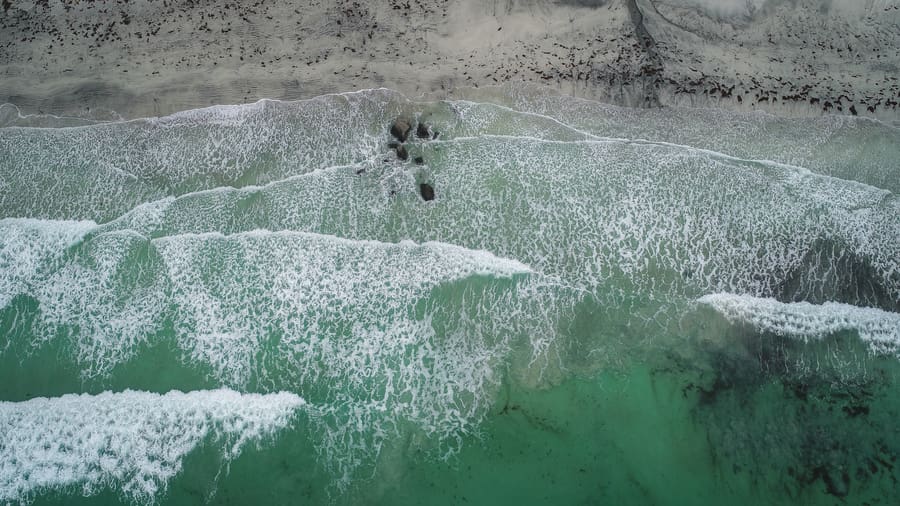
The swell is another key factor in beach photography. Lofoten Islands, Norway – Drone photo at 1/40 sec. f/3.2, ISO 100
I have two ways to analyze the swell and tide for seascape photography:
- Windy: Apart from the weather forecast, Windy also provides swell and tide forecasts using the local tide station. Again, it’s super easy to use and to understand thanks to their graphics and maps.
- Local surf forecast and webcams: Surfers need to constantly check the swell information, so the local surf forecast is another good option to consider. Also, don’t forget to check the local webcams if there are any; they will give you an idea of the weather and conditions.
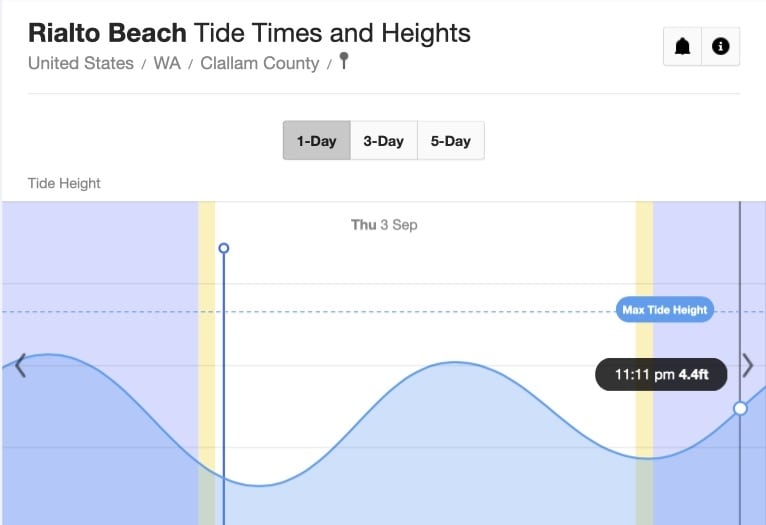
Tide forecast for Rialto Beach, Washington
Scout in advance for seascape photography
Scouting is one of the most overlooked concepts in seascape photography. It’ll allow you to be familiar with the location before you start shooting, so you’ll find the best photography compositions easier, and avoid unnecessary risks.
My recommendation is to first explore the chosen location for your coastal photography, especially if your intention is to shoot at sunrise/sunset or to do some ocean night photography. This will also prevent many of the potential dangers such as sneaker waves, exposed cliffs, slippery rocks, etc.
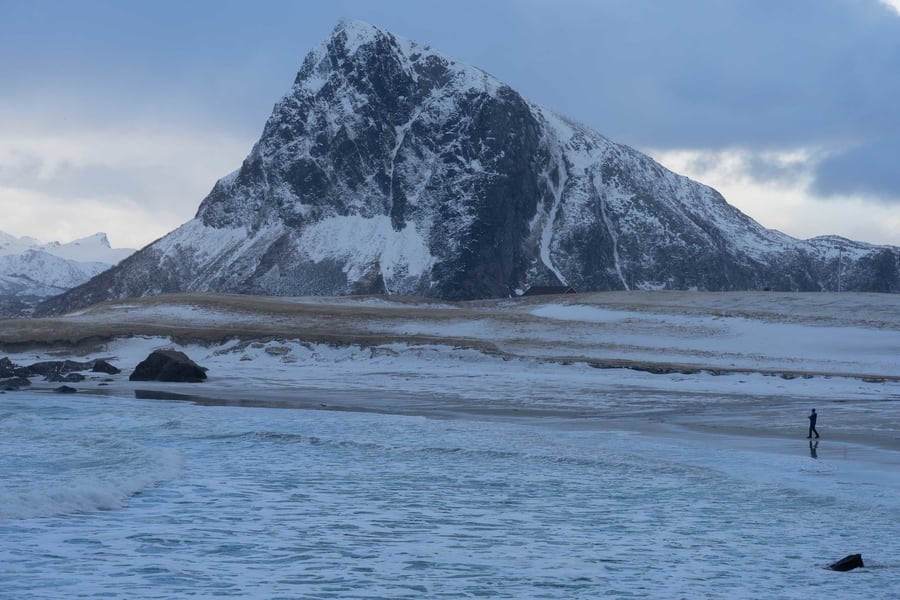
Scout your seascape location to look for compositions and possible hazards. Storsandnes, Norway – 1/160 s. f/8, ISO 125
Another good tip while scouting for your seascape photos is leaving your gear in a safe place, like in your car or on an elevated rock. You don’t need your camera hanging off your neck while exploring around.
Scouting close to the sea can be dangerous; the currents and the wind can make some locations particularly hazardous, so spend some time in a secure place looking for the safest points you can head to if any danger arises and, remember, never turn your back on the ocean! Some sneaker waves could catch you off guard and get you into serious trouble.
Best seascape photography settings
Like in any other type of photography, some knowledge of the photography basics and the basic camera settings is a must. There are no “general rules” in terms of seascape photography settings and you’ll have to adjust the settings according to the final seascape image that you want to capture.
That said, most ocean photos can benefit from using certain settings, so I’ll show you some good general seascape settings:
Aperture for seascape photography
When photographing seascapes, the goal is usually to capture a large depth of field to all the elements of your image in focus. To achieve this, besides using a wide-angle lens, set an aperture between f/8 and f/11. The narrower the aperture, the larger the depth of field will be, but take into account the optical diffraction starting above f/16 and other side effects like the spray and water drops that are more visible when shooting at small apertures.
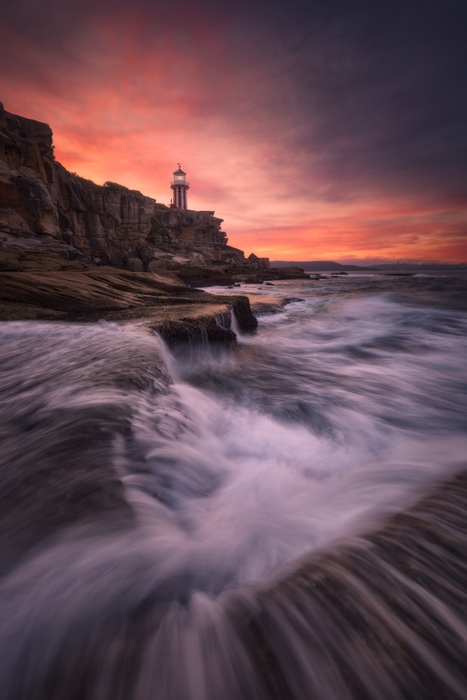
Small aperture to capture a larger depth of field. Australia – 1/2 sec. f11, ISO 50
On the contrary, you can use a wide aperture to highlight elements in your ocean photos using values under f/5.6, leaving the rest of the areas out of focus and leading the viewer’s eye towards the subject.
Additionally, if your intention is to photograph the night sky over the ocean, you will need a fast aperture with values below f/2.8 to capture more light.
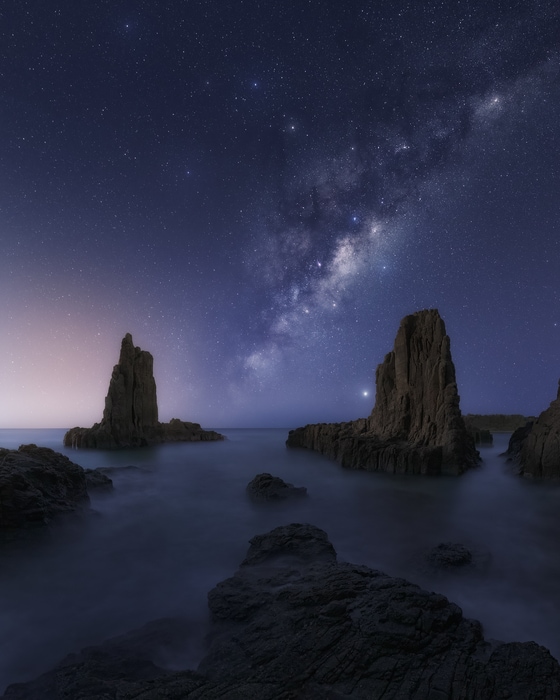
Wide aperture to capture more light. Cathedral Rocks, Australia – 20 sec. f/2.8, ISO 8000
If you want to master the aperture for seascape photography, I suggest checking our guide to photography aperture.
Shutter speed for coastal photography
Shutter speed is the cornerstone of beach photography, and setting the right shutter speed will make the difference between a good or a superb ocean photo.
The shutter speed drastically affects the overall look of any seascape image since the main element of coastal photography, the water, will be captured in a different way depending on the total exposure time.
Long exposure photography and seascape photography go hand in hand, so don’t hesitate to check our ultimate guide to Long Exposure Photography to learn more about this. The shutter speed varies depending on different factors, but as a general reference:
- Silky water: Use a shutter speed above 10 seconds to eliminate any textures on the water. This long exposure silky effect creates an ethereal and dreamy atmosphere in your seascape images by softening all the motion.
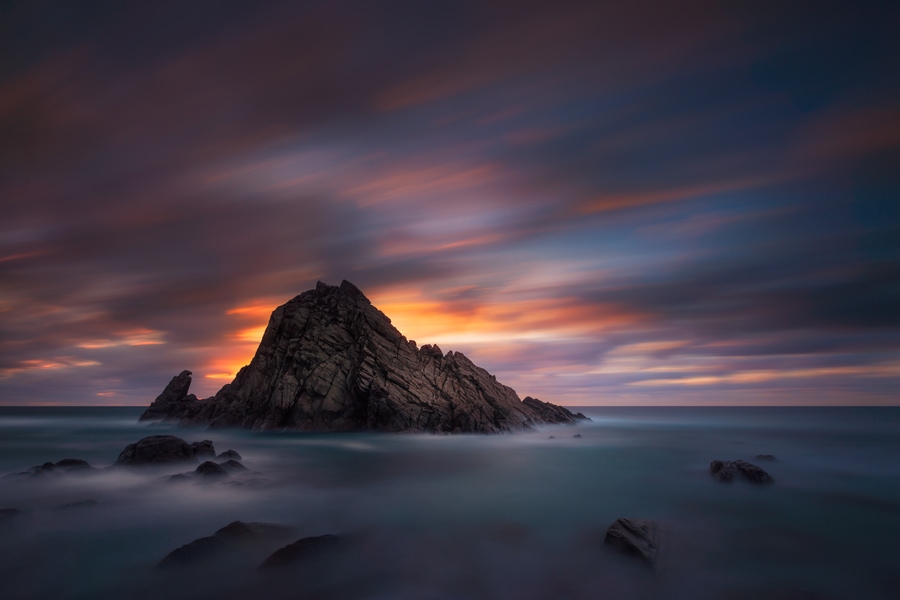
Silky water using a long shutter speed. Sugarloaf Rock, Australia – 105 sec. f/13, ISO 100
- Water flowing: Use a shutter speed between 1/4s and 1s. This is the best shutter speed to capture the motion of the water while preserving the textures and details, creating dynamic images with a more painterly look.
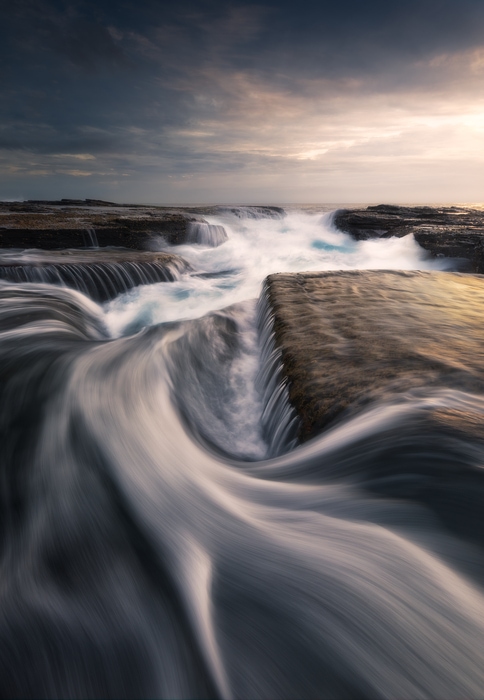
Shorter shutter speed to capture the movement of the water. North Narrabeen, Australia – 1/3 sec. f/13, ISO 100
- Freezing the motion: Use a shutter speed faster than 1/250 of a second to freeze the powerful motion of the sea and capture the beauty of the breaking waves.
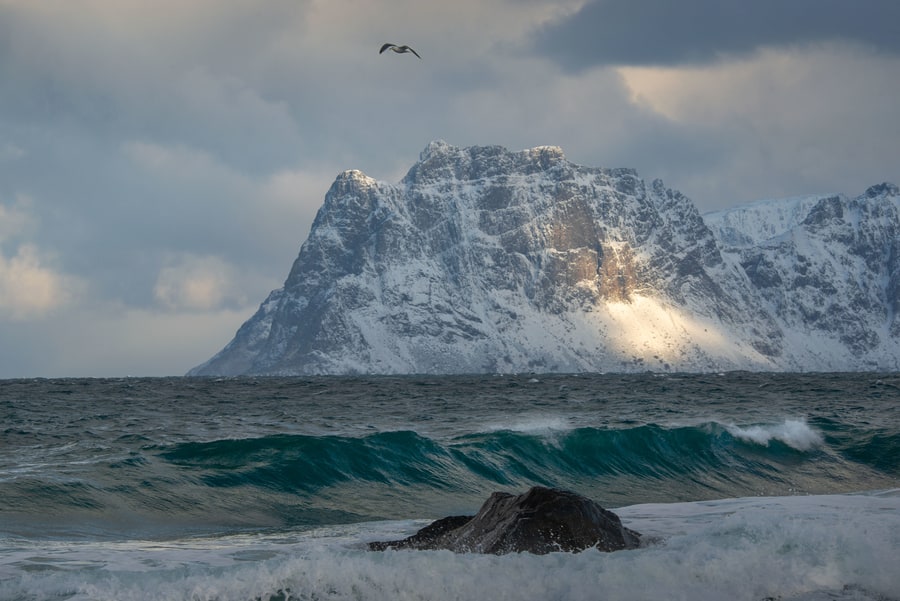
Fast shutter speed to freeze the motion of the water. Lofoten Islands, Norway – 1/250 sec. f/11, ISO 200
ISO for ocean photography
The best ISO for seascape photography is the “base ISO” of your camera, which will help you get an image with more quality and less digital noise. This seascape photography setting is quite similar to the ISO settings used for general landscape photography.
Keep in mind the final look you want for the sea photograph since you may have to raise the ISO in order to keep a slow shutter speed, especially before dawn and after dusk when there are low-light conditions.
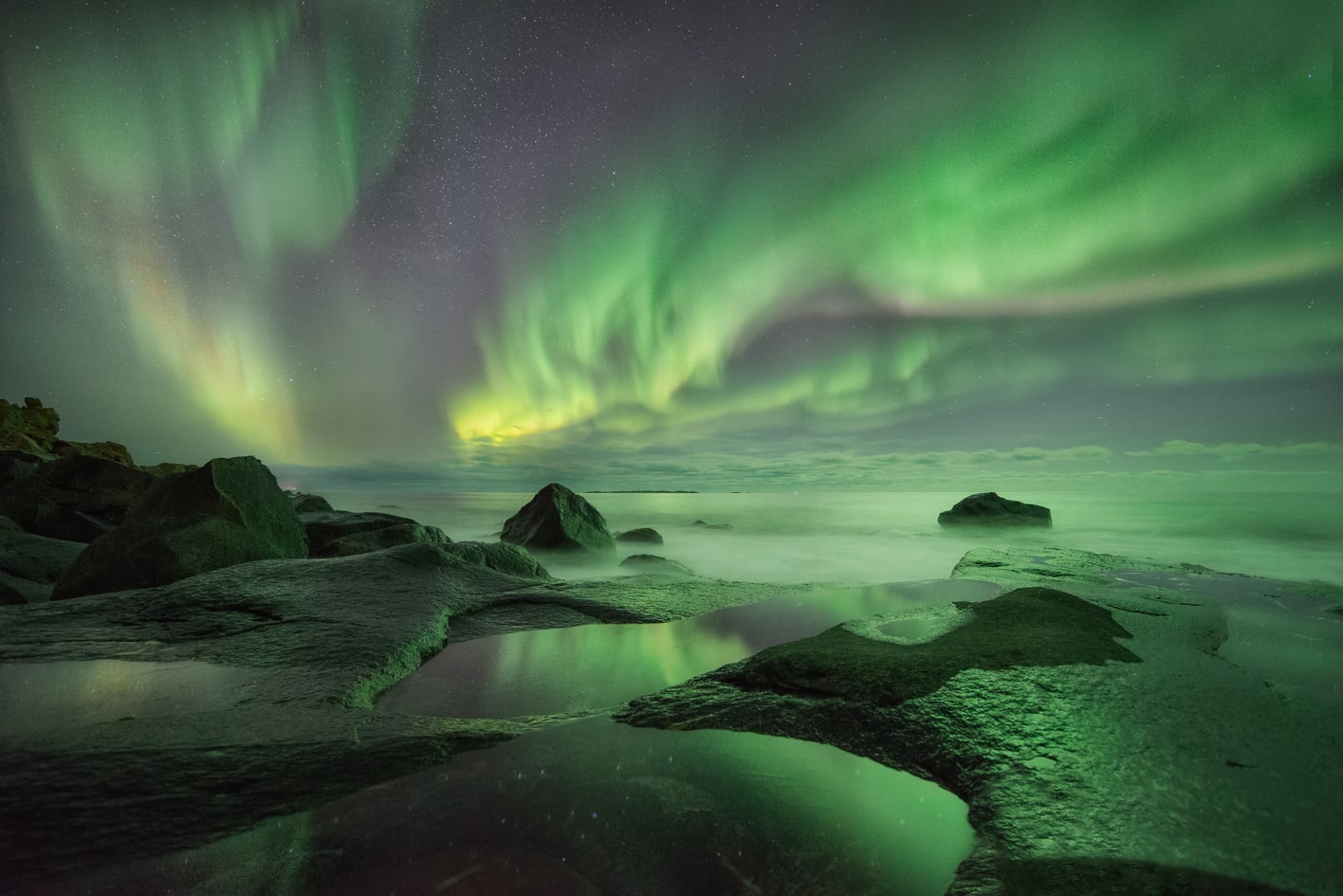
High ISO to capture this seascape with Northern Lights. Lofoten Islands, Norway – 4 sec, f/2.8, ISO 6400
If you’re planning to shoot seascapes at night, don’t hesitate to increase the ISO as much as you need within the limits of your camera. We speak more about this in our Milky Way photography guide. If you end up with a noisy image, you can always use any noise reduction software to eliminate the digital noise. The option I always use in these cases is Topaz Denoise AI.
Other settings for ocean photography
Besides the basic settings for seascape photography, you should also bear in mind the following general camera settings to take ocean photographs like a pro:
- Shoot in Raw to make the most of your files in post-production.
- Use the Auto White Balance if you plan to shoot seascape panoramas or night shots.
- Use the Matrix/Evaluative/Multi metering mode.
- Focus correctly on your seascape images as we explain in our guide to focusing in photography.
- Use the burst mode when you want to capture the action in your seascapes.
Essential gear for seascape photography
We have gone through the necessary settings to master the art of photographing seascapes, but what kind of gear do you need to get the most of the ocean scenes that you want to capture?
The best camera gear for seascape photography depends on different factors. Generally, it’s quite similar to the camera gear used for travel photography but there are a few extra things to consider. Let’s check them out!
Best lens for seascape photography
The best lens for seascape photography depends on the subject that you want to shoot:
- Wide-angle lenses: Ideal for capturing the movement of the water but also to incorporate more elements in your seascape compositions.
- Mid-range lenses: Good for filling up the frame and highlighting subjects within the scene.
- Telephotos: The best for sea waves photography and distant objects, as well as abstract and intimate seascape details.
Filters for ocean photography
The use of lens filters in long exposure seascape photography is essential. There are two types of filters you may need: Polarizing filters and Neutral Density Filters (ND filters). I highly recommend using a polarizer filter to avoid unwanted glare on the water, especially while shooting rockpools.
Regarding the ND filters needed for oceanic photography, these are the best for taking long exposure seascapes. I always recommend having a series of ND filters of 3, 6 & 10 stops. I never recommend gradient filters since they can produce side effects like darkening unwanted areas of your photo and you can achieve the same result in post-processing.
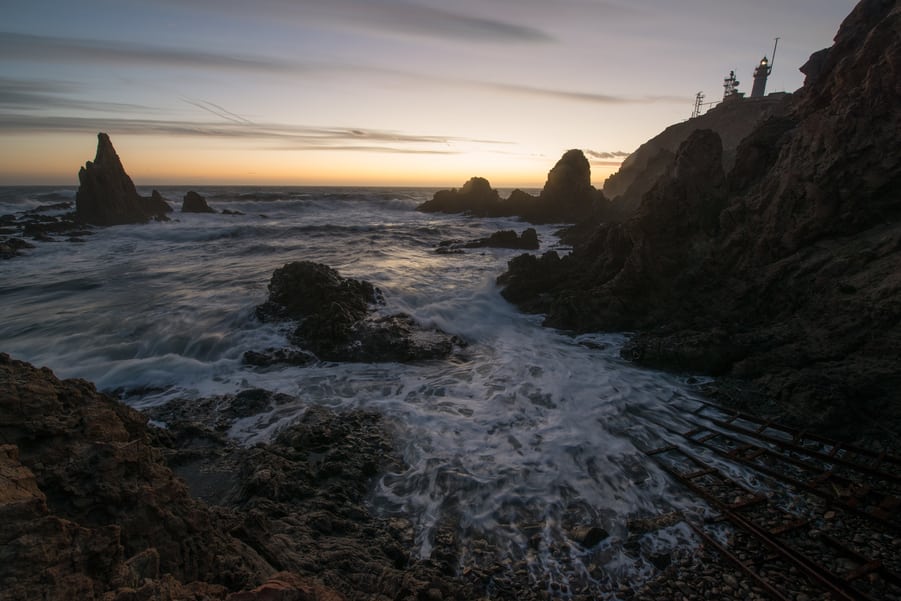
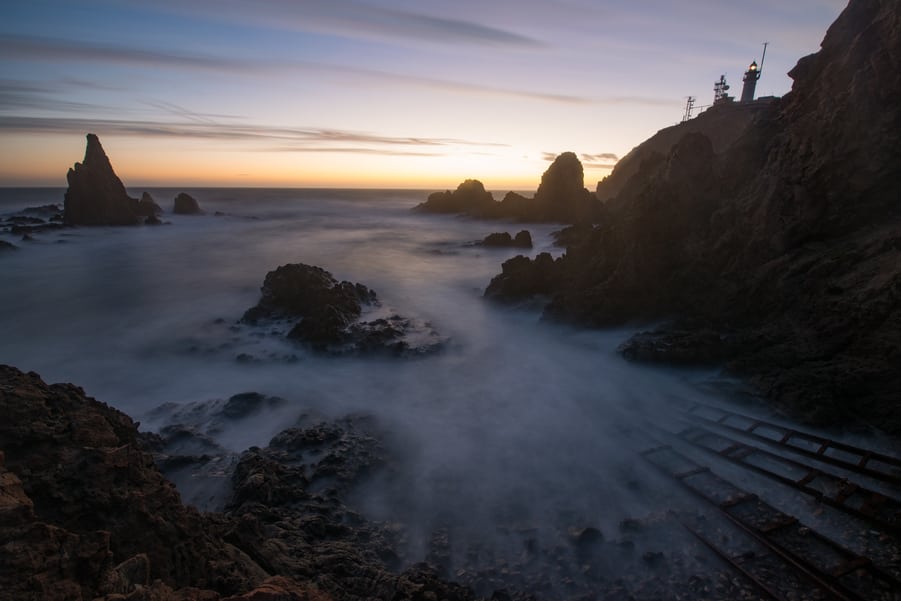
ND 10 stops filter. f/8, ISO 320. Before shot 1/4 sec., after shot 30 sec.
You can check more info on the best types of filters and how to use them in our guide to lens filters.
Tripods for sea photography
A sturdy tripod is a critical piece of gear for seascape photography. If you want to take sharp images, invest in a good tripod that can stand the currents and waves.
Don’t forget to wash your tripod after every beach photography session to keep your gear in good condition and free from corrosion.
Other equipment
Other pieces of gear for ocean photography are:
- Remote shutter: To avoid any vibrations and capture the right moment when photographing waves.
- Microfiber cloth: This is one of the most simple and underrated items in beach photography. The ocean mist and crashing waves will affect your lens and final images, so keep a couple of microfiber cloths in your pockets at all times.
- Camera rain cover: For those occasions when you have to shoot under rainy conditions.
- Waders: There is always a high chance of getting wet when doing coastal photography, so be ready to take a pair of waders to stay dry and comfortable.
- Lens heater: This is one of the best items for doing long seascape sessions at night if you want to prevent your lens from fogging up, especially if you shoot beautiful seascapes in cold environments like in Iceland or the Lofoten Islands.
The best seascape photography tips
We’ve already seen all the seascape photography basics for any type of coastal photography. However, mastering this genre requires a lot of trial and error (and getting soaked too!)
For this reason, I wanted to provide a few extra tips for seascape photography that I’ve found to be essential throughout the years.
1. Plan your seascape photography sessions in advance by checking the weather, tides, and swell.
2. Scout, scout, and scout again! Explore the area to find your composition, especially when you plan to shoot in low-light conditions.
3. Safety first! Spend some time watching the sea before setting up your gear and be aware of the coastal hazards while shooting.
4. Wear waders or shoes with a good grip to avoid dangerous slips and falls.
5. Leave all the equipment you don’t need like the camera bag, filters case, etc., in a safe place like on top of a rock.
6. Use a lens cleaning cloth to clear up the spray and water drops from your lens.
7. Composition is the key to creating beautiful seascapes. Take the time to find the best seascape composition.
8. Check the histogram in order to get the final seascape photo you want and use advanced techniques such as bracketing or focus stacking if necessary.
9. Get out of your comfort zone! Get closer, get low, do panoramic seascape photography… try new perspectives and techniques.
10. Enjoy the experience. Even if you don’t take a superb shot, you’re lucky to spend a good day in nature, so be grateful and enjoy the experience of photographing the sea!
Seascape photography ideas
Even though I encourage you to follow your own artistic vision when photographing seascapes, I believe that analyzing and studying other photographers’ work is one of the most powerful ways to improve and develop your own photographic skills. To help you boost your creativity, I’m sharing below a few good seascape photography ideas:
Sunrise seascape photography
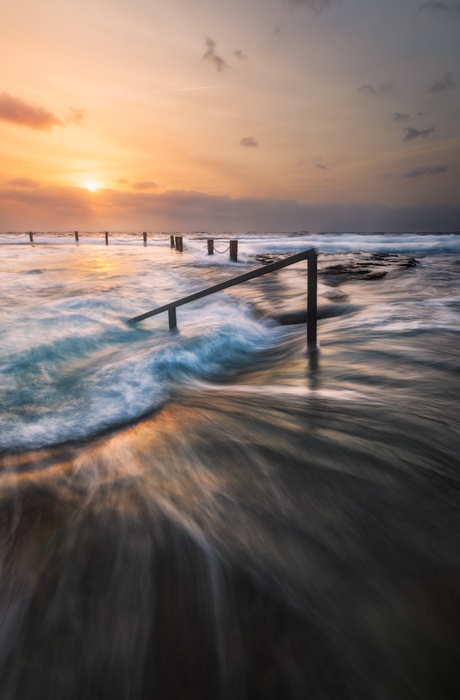
Seascape image at sunrise. Australia – f/16, 1/40s. ISO100
Seascape and blue hour
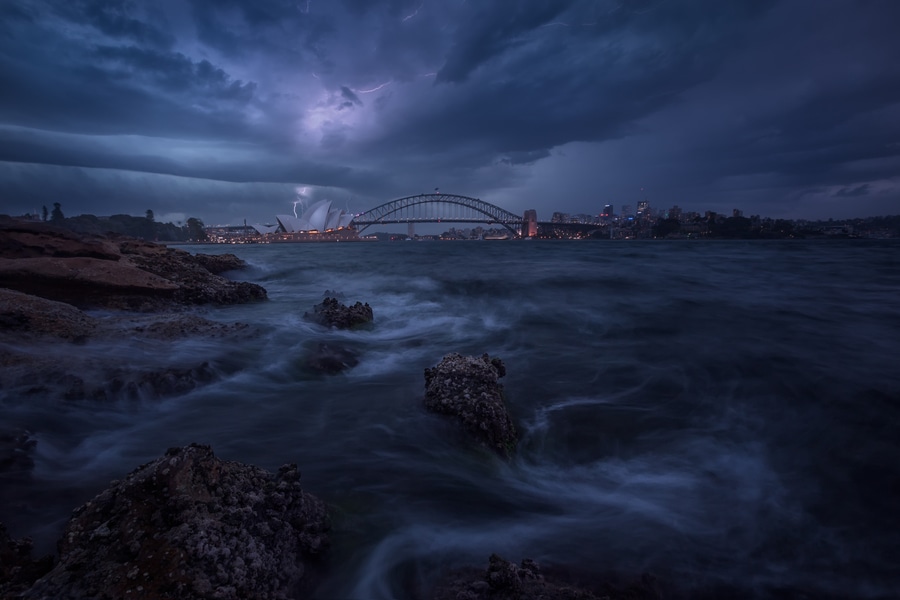
Seascape picture during blue hour. Sydney, Australia. 1sec. f/11, ISO 320
Daylight seascape photography
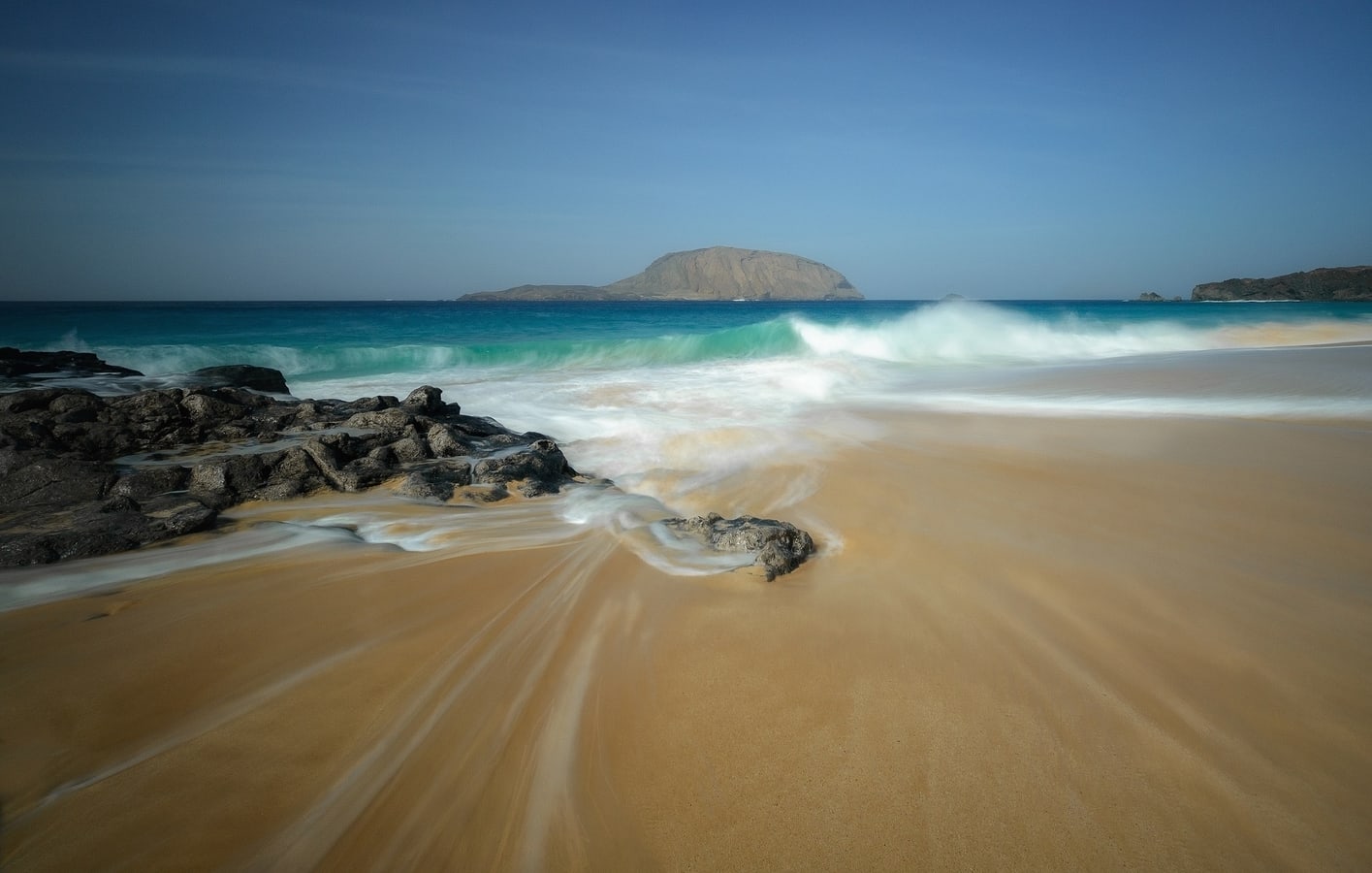
Seascape photo during the day. The Canary Islands, Spain – 1.3 sec, f/8, ISO 500
Seascapes and water flows
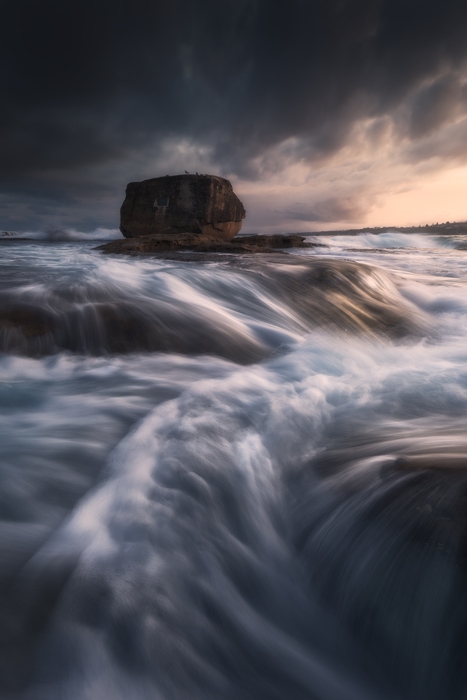
Waterflow in a seascape. Australia – f/14, 0.3s. ISO100
Seascapes with lighthouses
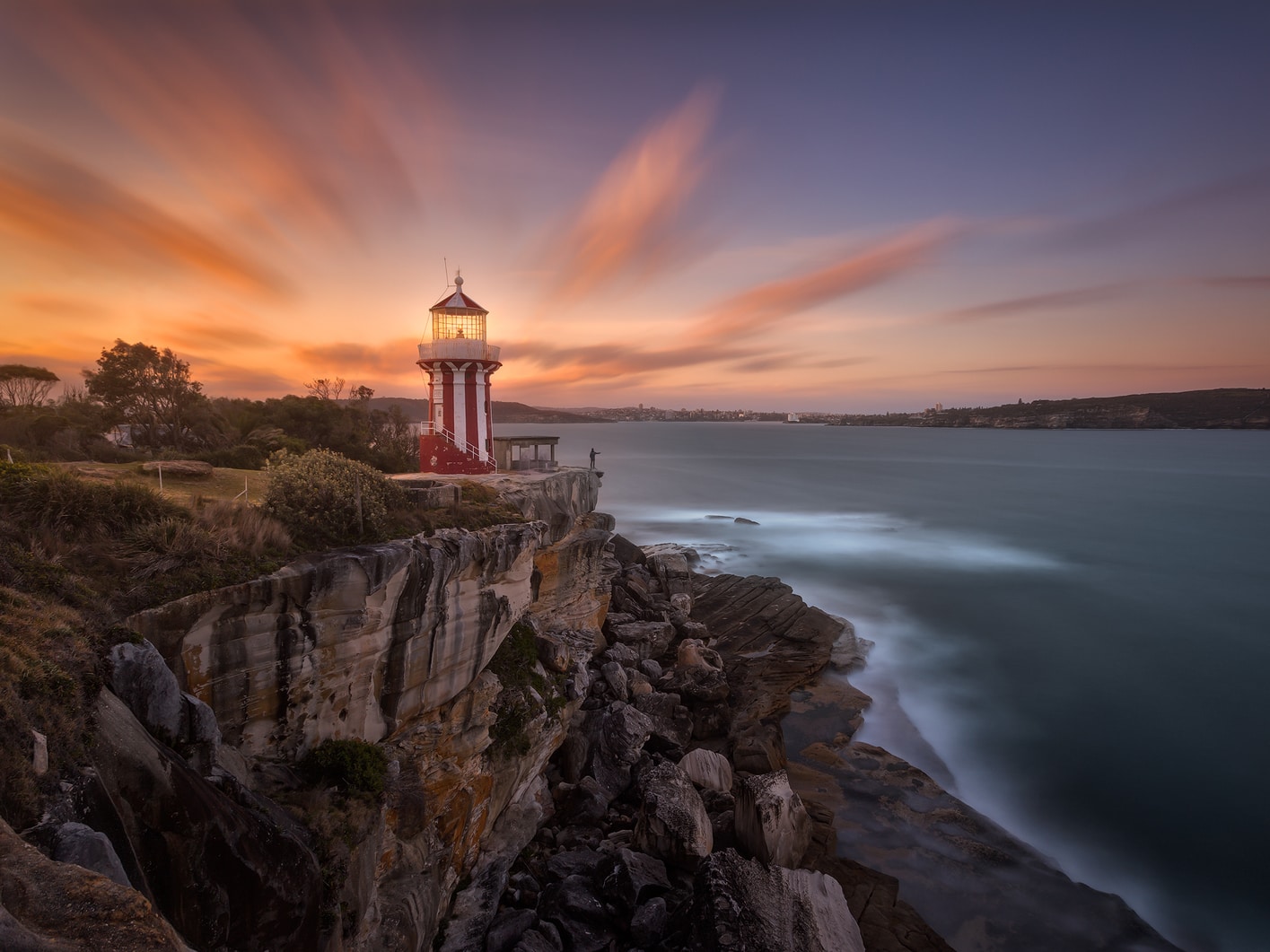
Seascape and lighthouse image. Sydney, Australia – 240 sec. f/11, ISO 50
Sea waves photography
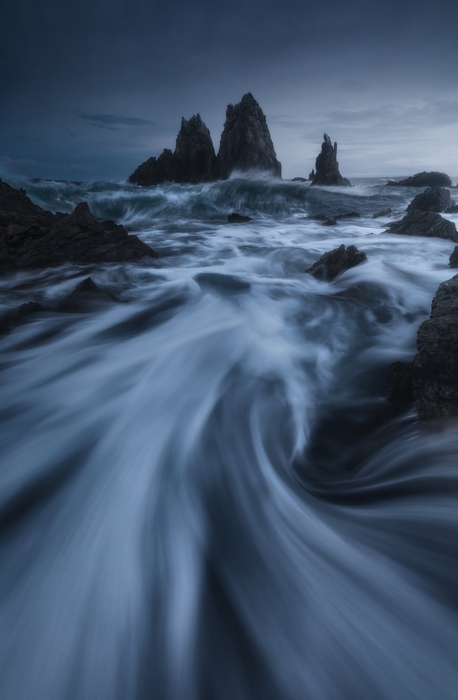
Sea waves shot. NSW, Australia – f11, 0.3s. ISO 320
STORMY SEASCAPES

Seascape and thunderstorms. Sydney, Australia – 1.6 sec. f/11, ISO 50
Seascapes with rocks
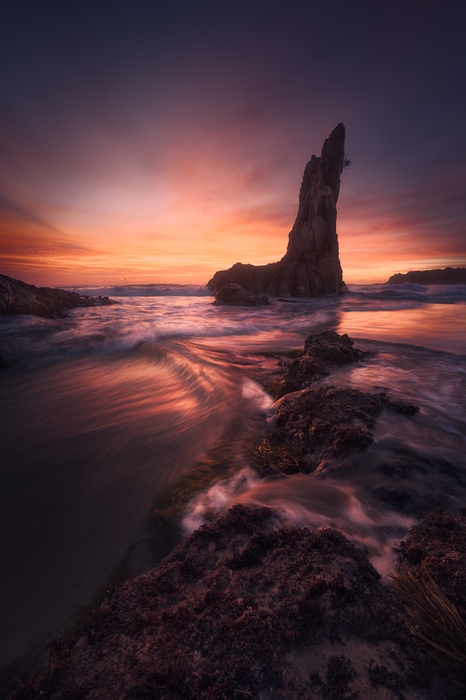
Rocky seascape photograph. Australia – f/11, 0.6s. ISO400
Seascapes and Tidepools
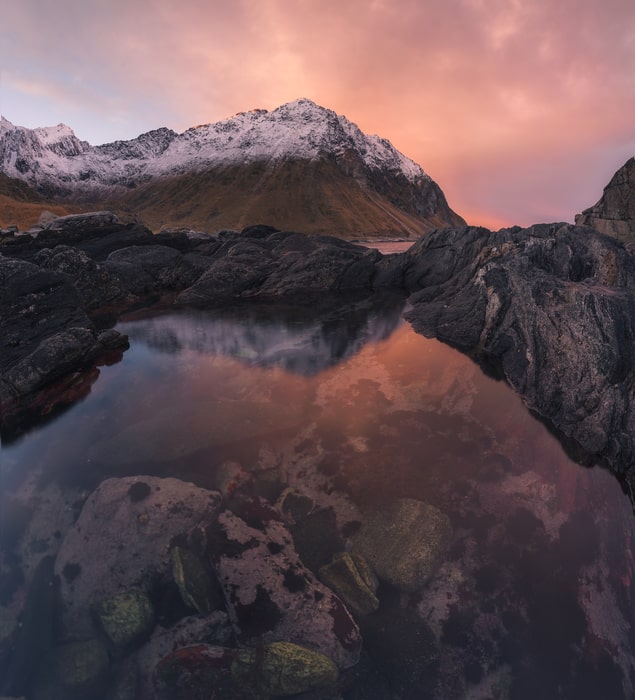
Seascape and tidepool. Lofoten Islands, Norway – 1s. f/8, ISO 320
Mountain seascape photography
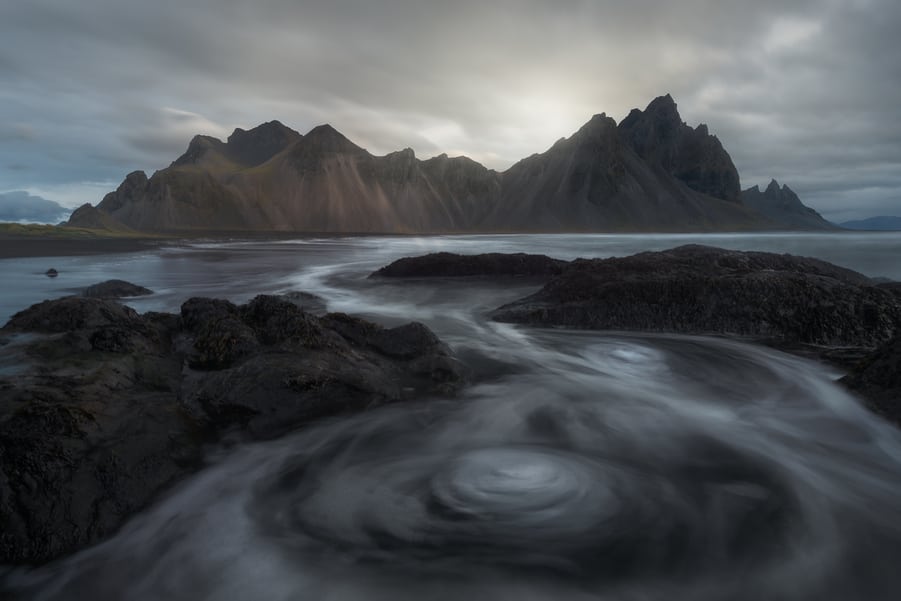
Vestrahorn mountains and Stokksnes beach. Iceland – 8 sec, f/11, ISO 100
Arctic seascape photography
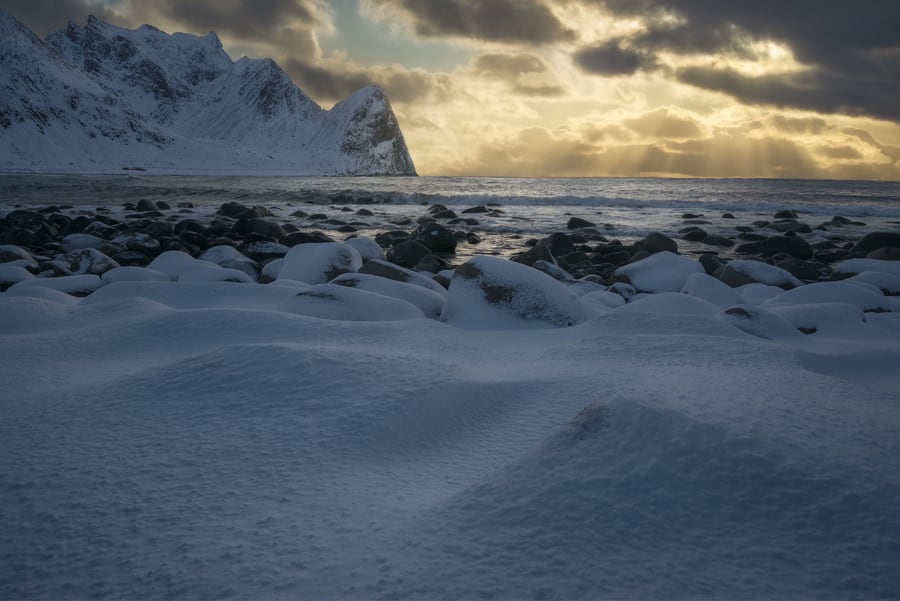
Beach Photography in the Arctic. Unstad beach, Norway – 1/30sec. f/11, ISO 400
seascapes and ice
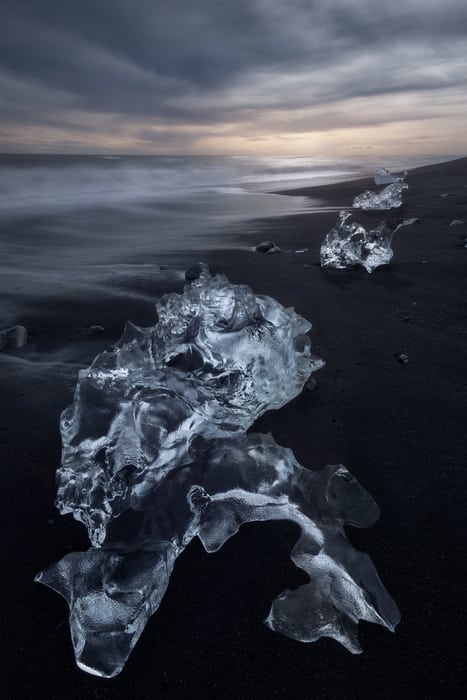
Glacier ice at Diamond Beach, Iceland – 0.8 sec, f/16, ISO 100
Volcanic black sand beaches
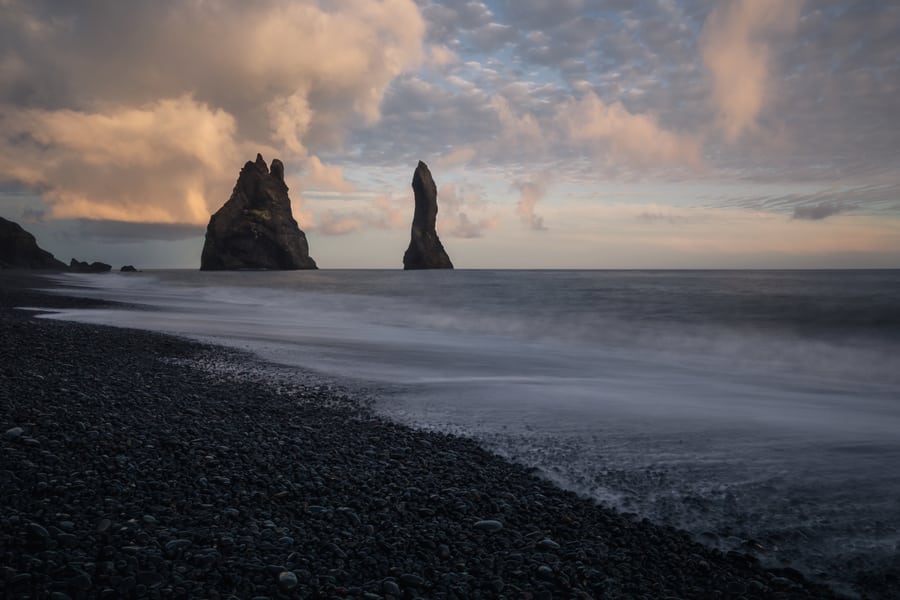
Volcanic black sand beach. Reynisfjara beach, Iceland – 3 sec, f/22, ISO 200
SEASCAPE ASTROPHOTOGRAPHY
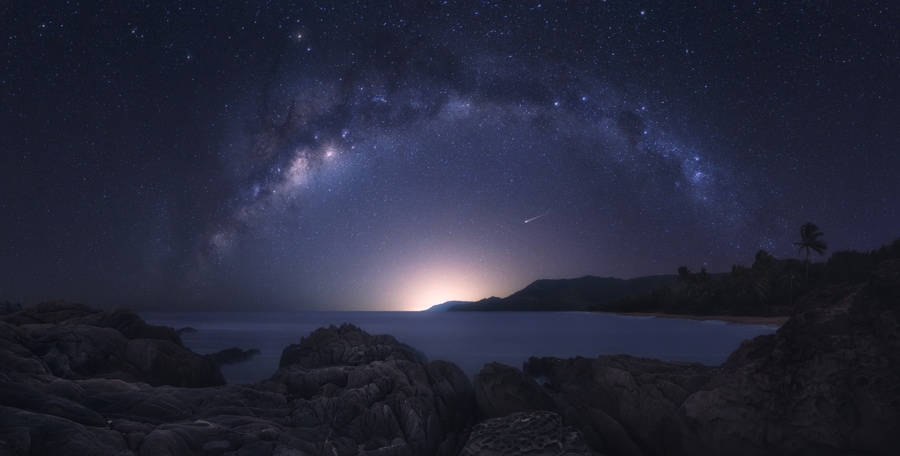
Beach photograph and the Milky Way – Thala Beach, Australia – 20 sec. f/4, ISO 3200
Seascapes and Northern Lights
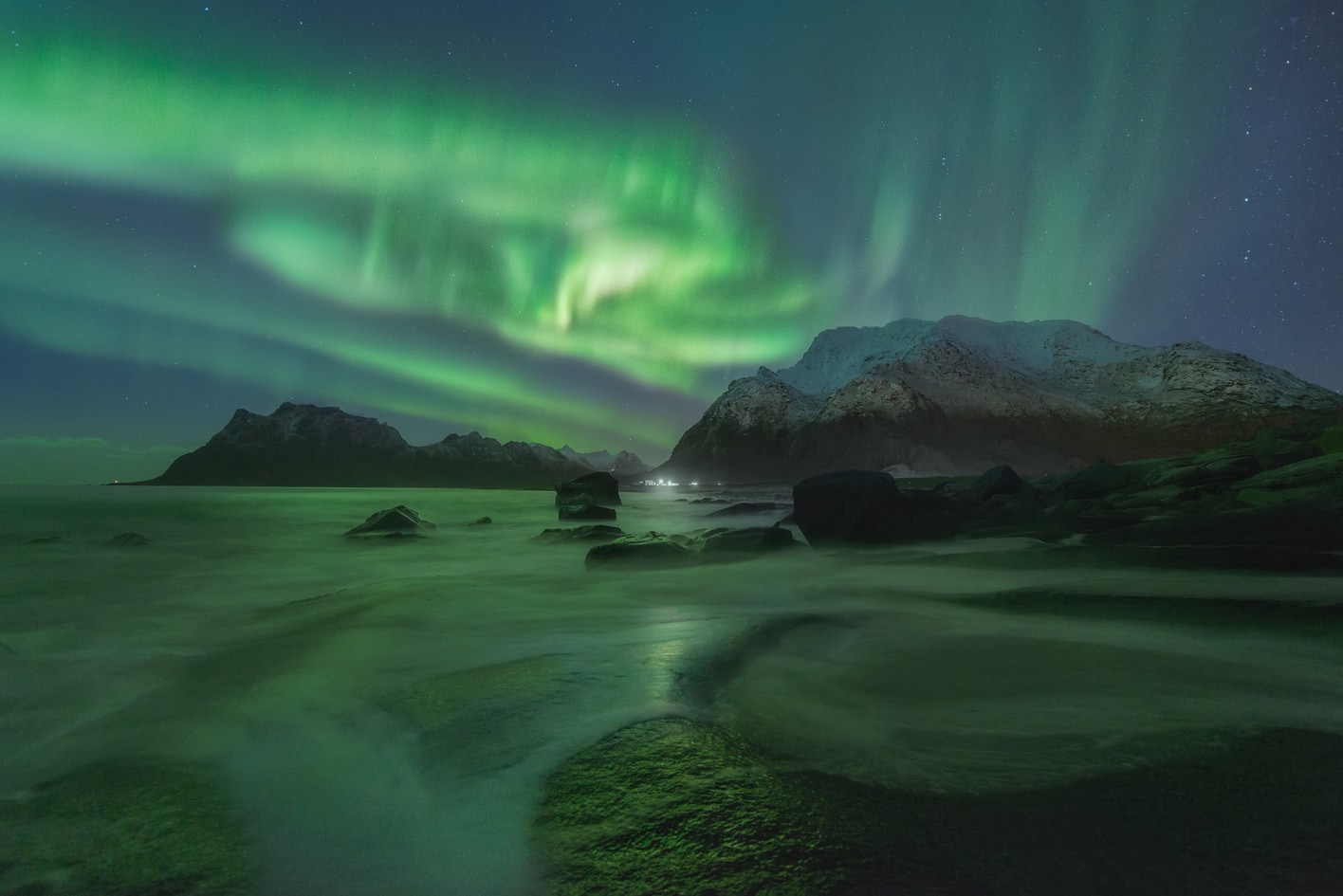
Aurora Borealis seascape. Uttakleiv Beach, Norway – 8 s. f/2.8, ISO 2500
Abstract seascape photography
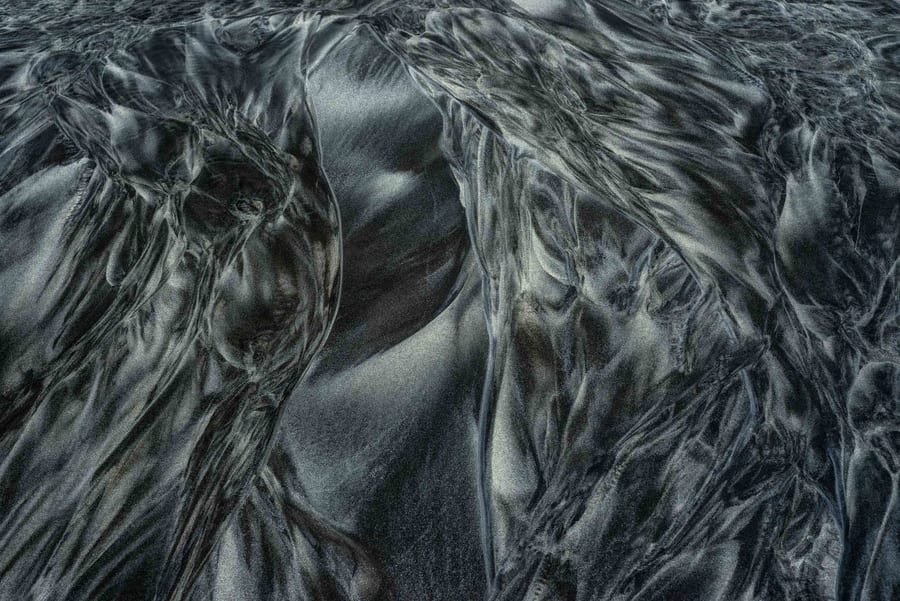
Abstract seascape image of a sand pattern. Skagsanden, Noway – 1/125 sec. f/8, ISO 800
Aerial seascape photography
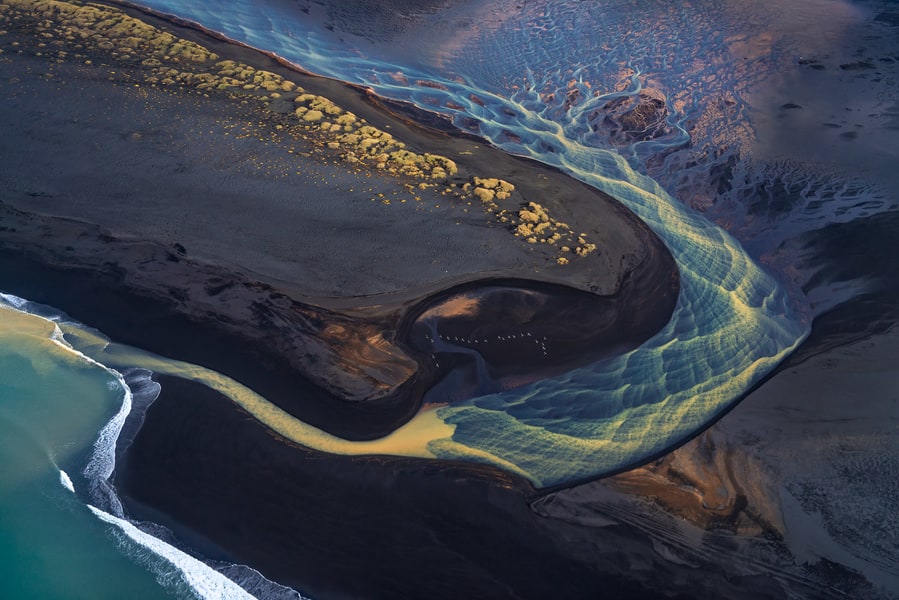
Aerial seascape image from an airplane. Iceland – 1/2000 sec. f/2.8, ISO 400
Seascapes and Wildlife
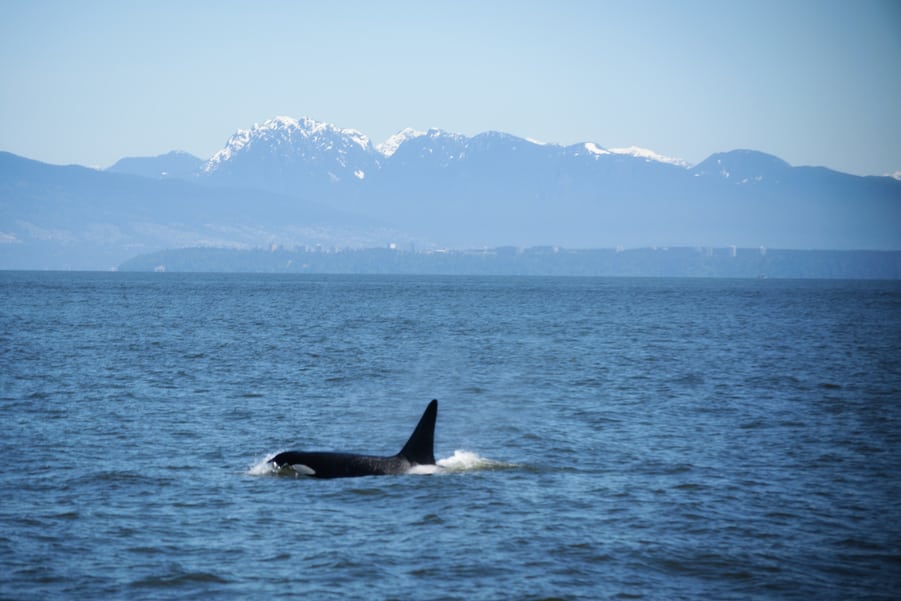
Seascape and orca image. Vancouver Island, Canada – 1/400 sec. f/9, ISO 100
City seascape photography
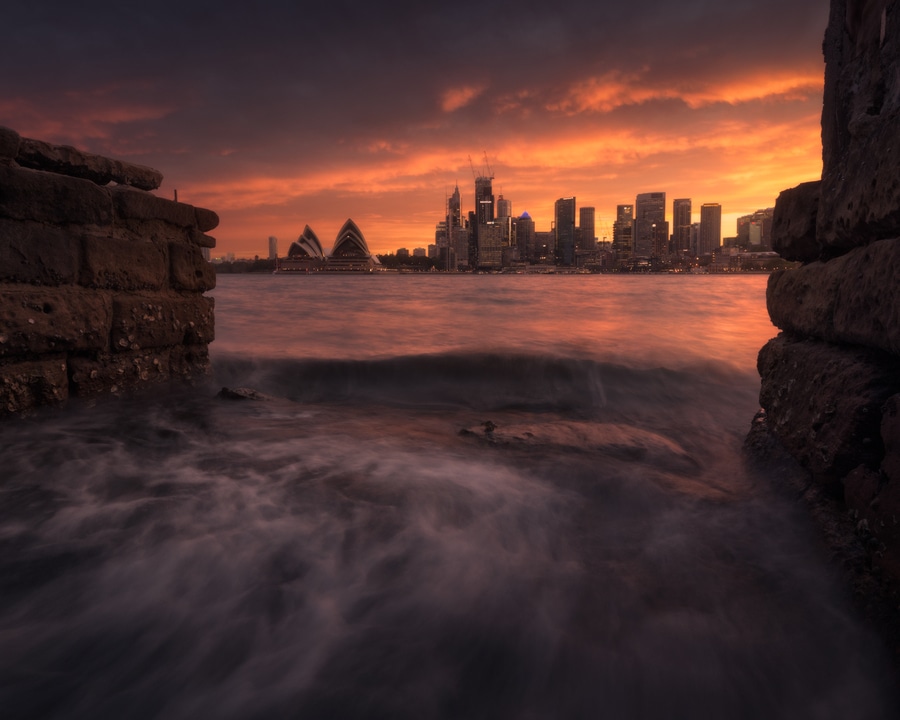
Seascape photography in the city. Australia – f/11, 1.3s. ISO250
Seascapes and architecture
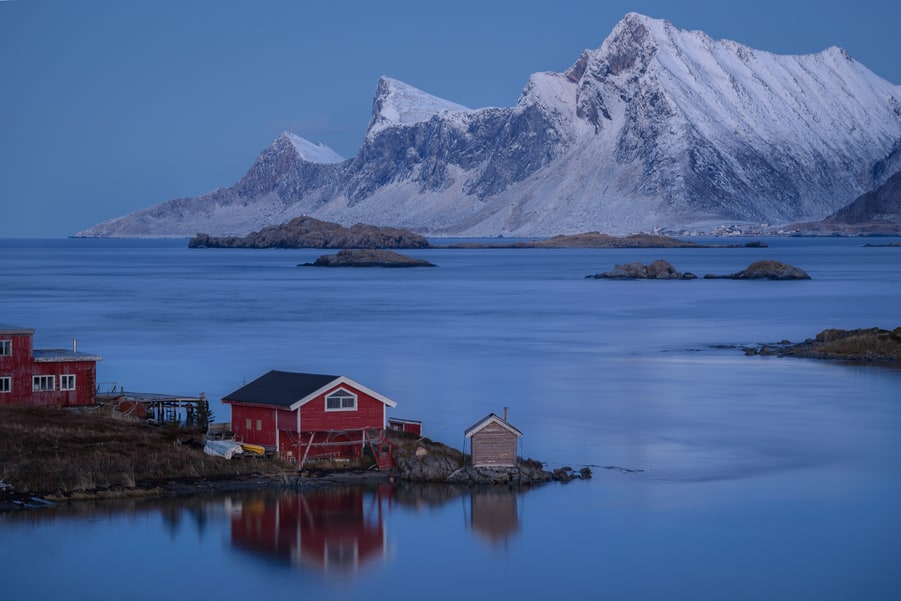
Seascape image and fisherman house. Lofoten Islands, Norway – 20 sec. f/4.5, ISO 100
Conclusion
Seascape photography is a thrilling type of photography with endless possibilities and ever-changing scenes.
The deeper you immerse yourself in ocean photography, the more you’ll feel the need to capture seascapes in different places and conditions. Ocean photography is also one of the best genres for connecting with nature and your viewers, and I’m sure that mastering your skills in seascape photography will be a turning point in the way you understand photography and your relationship with the sea.
Lastly, don’t forget to keep in mind all the hazards involved in coastal photography. It’s fine to get wet but, please, stay safe!
I really hope that this seascape photography tutorial encourages you to capture the beauty of the ocean and helps you become, wave by wave, a better seascape photographer!
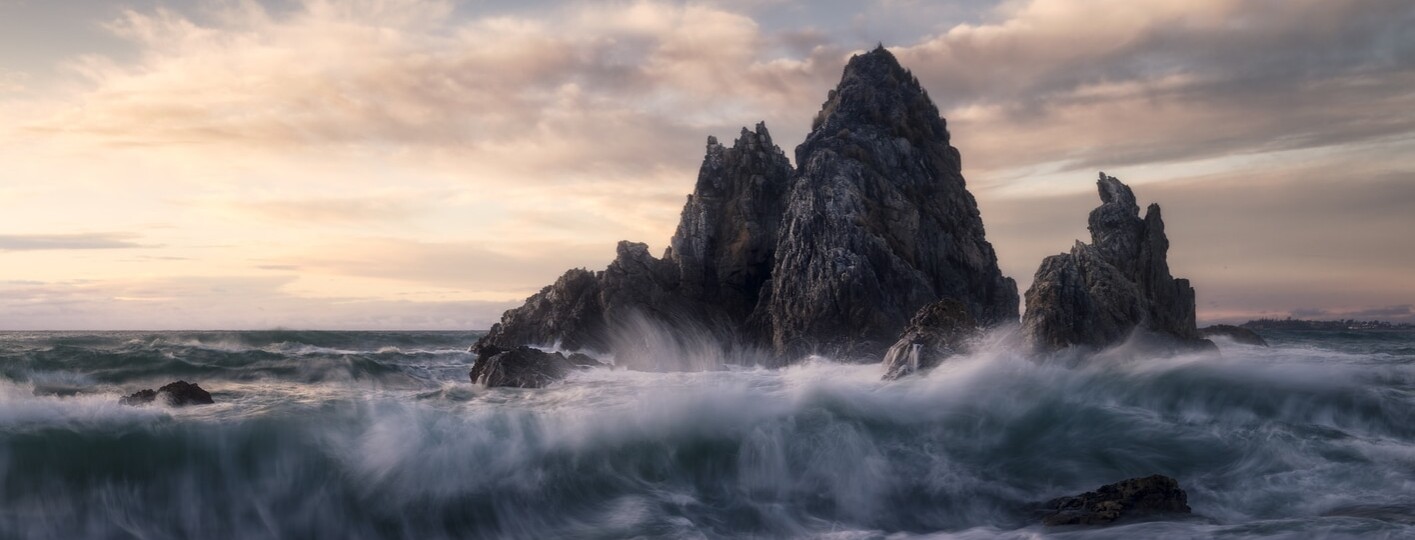
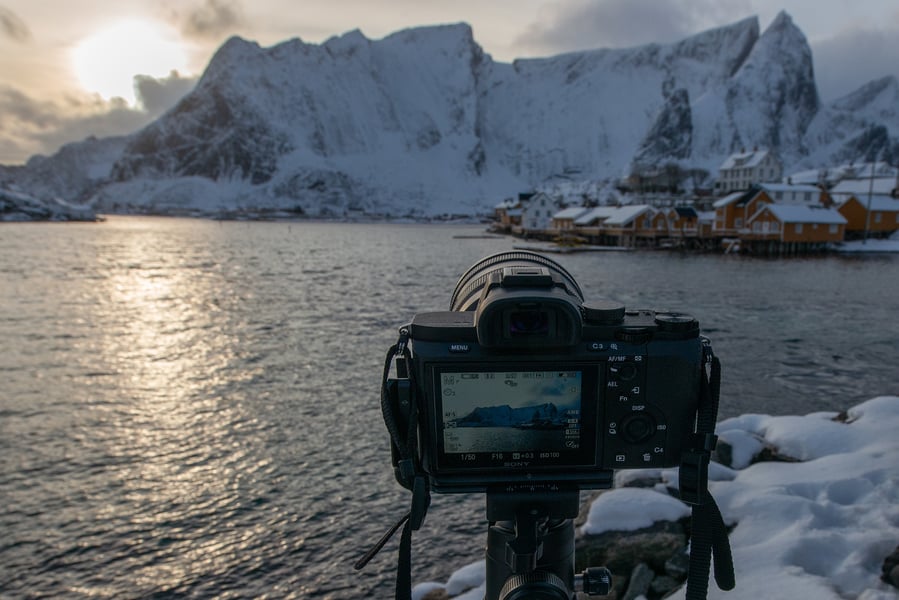


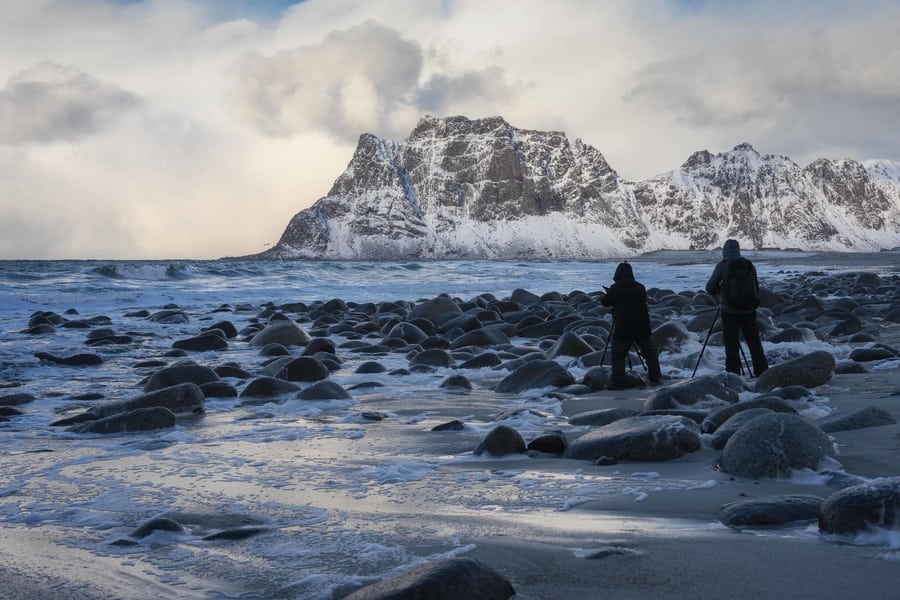
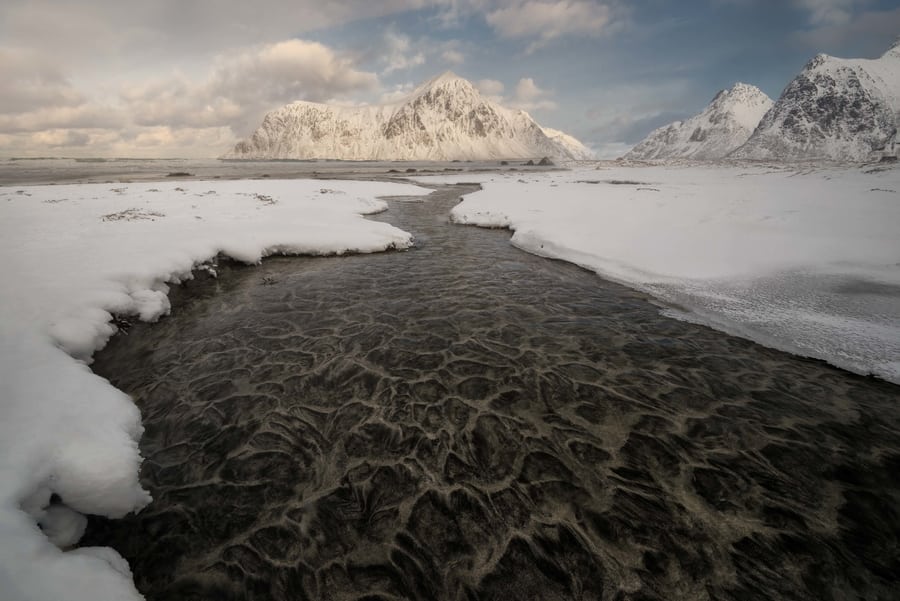
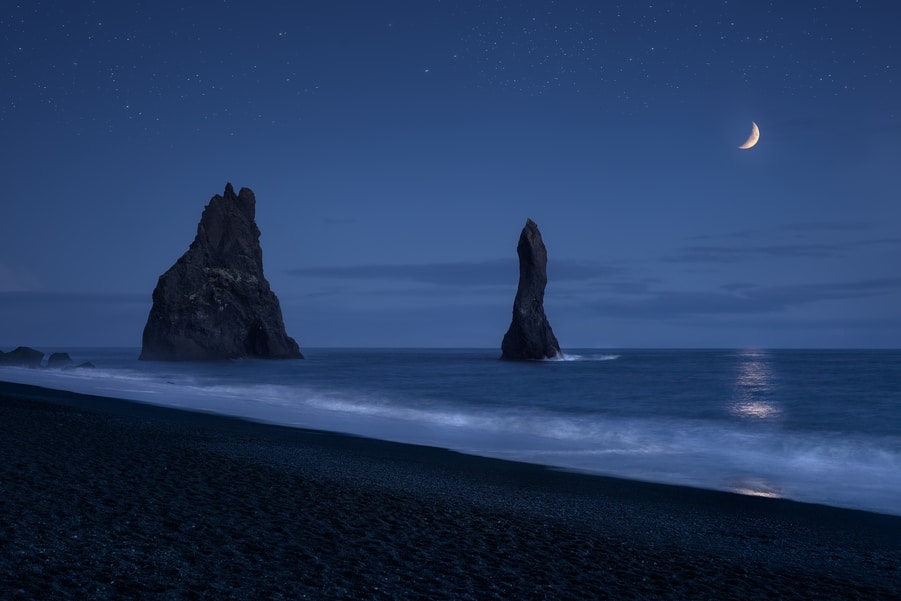
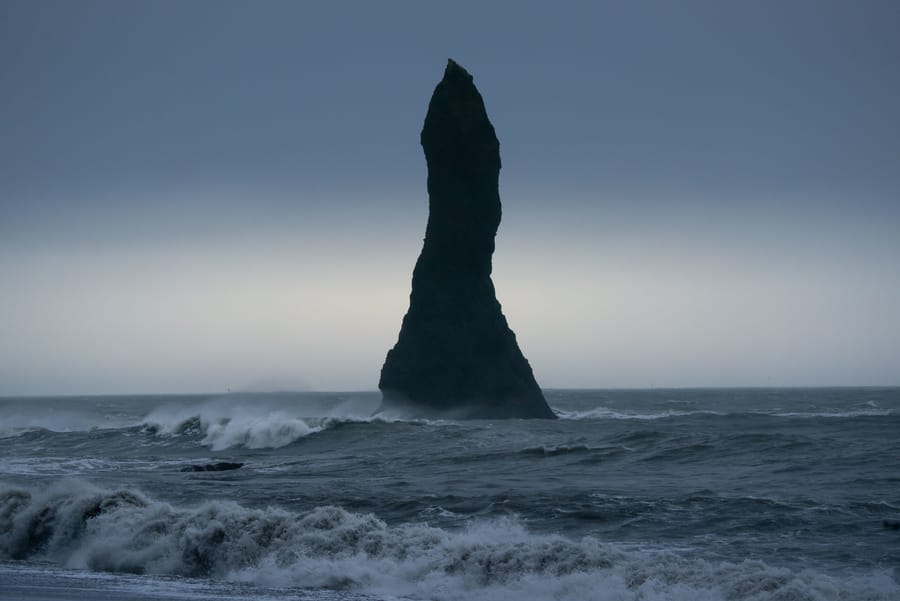
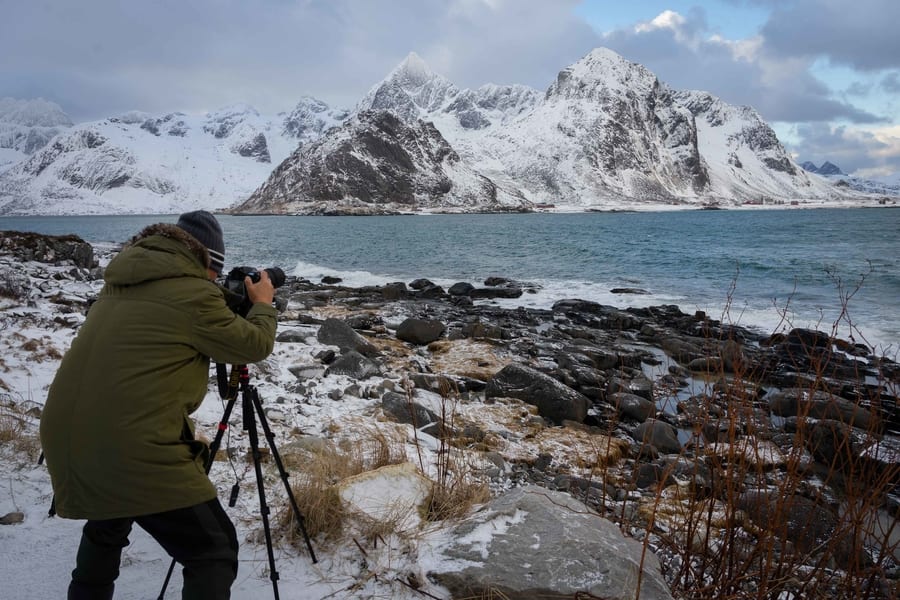


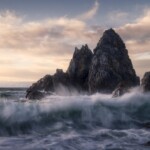
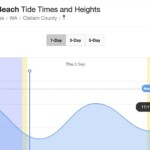
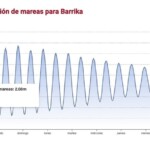
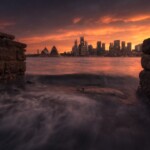
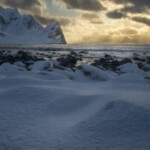
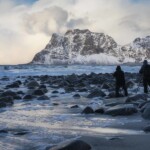
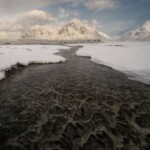
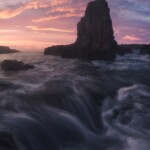
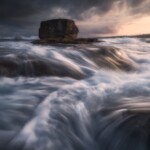
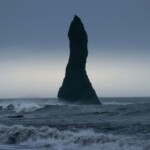
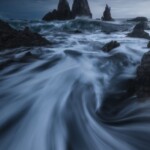
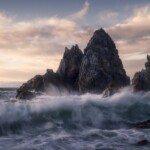
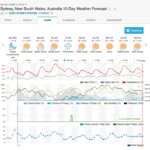
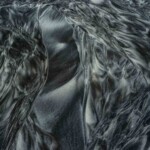
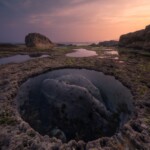
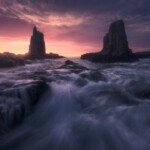
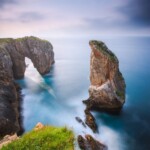
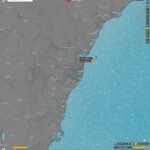
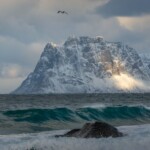
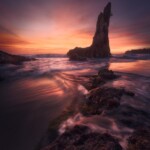
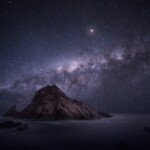
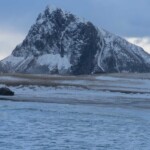
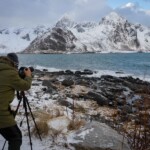
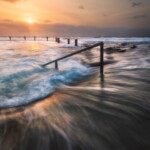
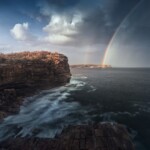

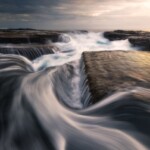

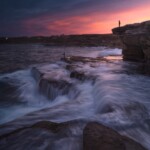
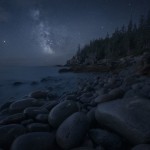
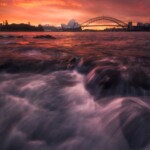
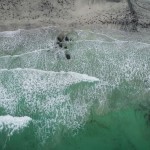

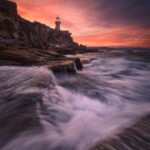

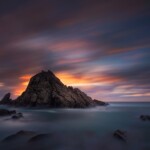
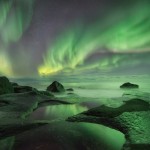
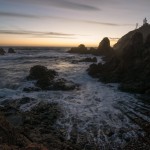
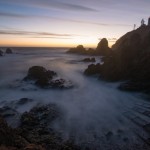
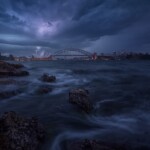

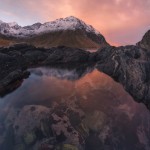
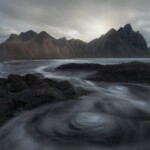
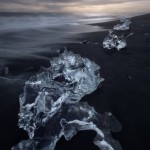
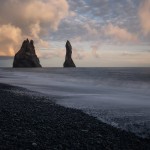
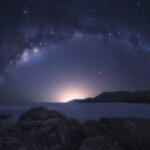
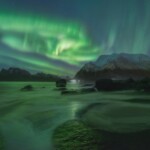
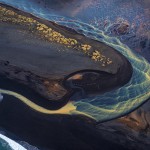
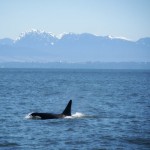
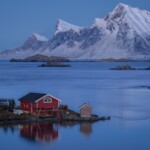
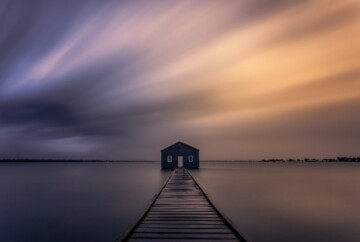
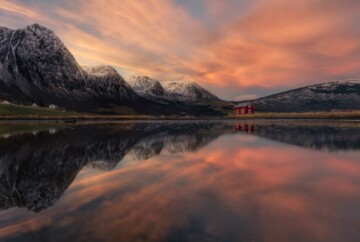







BEST ARTICLE I HAVE READ
Thanks!